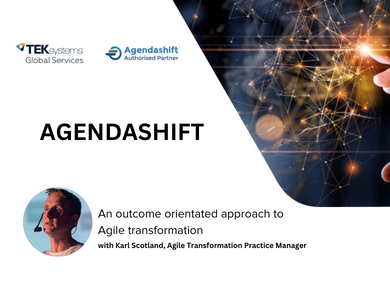Agendashift – An outcome orientated approach to Agile transformation
How to improve agile transformation using the Agendashift model

Agile transformations are often approached as an operating model deployment; centrally defined, planned, and rolled out until completion. They typically assume a standard blueprint for change that risks resistance and employee disengagement by imposing something that may not work. Agendashift(TM) provides a different approach to change by asking three important questions:
- How can we agree outcomes before solutions?
- How do we keep bringing outcomes to the foreground?
- Where else could we develop and pursue this strategy?
Agendashift is an outcome-oriented (rather than solution-driven) approach made up of a mix of principles, patterns, and strategies. It serves as an engagement model (rather than a process framework) by inviting employees to participate in designing, developing, and evolving their own ways of working – contextually relevant and aligned to specific business needs.
In this webinar, Michael Alexander and Karl Scotland from TEKsystems Global Services’ Strategic Agility practice, discuss the Agendashift theory and make three recommendations to support effective agile transformation: invite and engage people, act in the present and run experiments.
Invite and Engage People
Research shows that in successful transformations, employees in every role tend to be more engaged. Especially at lower levels of the organisation. Agendashift engages people by starting with a question – How would it look if everyone was able to work consistently at their best? It includes an inclusive, non-prescriptive and framework agnostic assessment, completed by everyone involved in doing the work. The aggregated results provide context for a debrief and discussion to collaboratively align on key areas and opportunities for improvement. This leads into a Clean Language-inspired exercise in moving “From Obstacles To Outcomes” (FOTO), which encourages participants to envision a path to change.
Act in the Present
Traditional change management typically involves designing an ideal future state, which is significantly different from the current state and requires large changes to close the gap. Agendashift, by contrast, focuses on the present and making small individual and incremental changes which will improve the current state over time. Through the Agendashift approach, positive outcomes are identified as a result from removing existing obstacles currently blocking the path of moving towards an ideal.
Run Experiments
Agendashift is based on the premise that we cannot know what solutions are going to work in advance. Hence the need to invite and engage people and act in the present. There is a need to learn which improvements are feasible from the many adjacent possibilities. Learning comes from failure, so many small safe-to-fail experiments are required. To encourage idea exploration and experimentation and to avoid jumping straight to a preconceived solution, Agendashift puts meaning before measures and methods. Thought outcomes and key learns are communicated on a single page template, known as an Experiment A3.
Agendashift provides an alternative approach to change in today’s complex world. TEKsystems Global Services can help you invite and engage people, act in the present and run experiments with our “Agendashift: Leading with Outcomes” workshop and coaching service. Over the course of a week, we can get everyone on the same page, get to the issues that matter, organise your strategy visually, move from outcomes to action and design your ongoing transformation strategy rhythm. Then we will help you review progress, capture learning and adjust your plans as you begin the journey of outcome-oriented, continuous transformation.
*The original video featured in this webinar was created by Jason Little, Founder of Lean Change Inc.